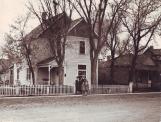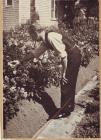14
He had the ideal background for this position. His rigourous training in ceramics and painting well prepared him for his duties. If anything, he was likely over qualified for the job. In a pottery factory that was mass producing fairly utilitarian goods, his vast knowledge was not fully utilised. However, it may have been exactly that thorough early training that both Tom and Bill received in England, that gave Medalta the ability to meet the demand of ever changing consumer tastes by constantly introducing new designs, whether their own or knock-offs of pieces from American catalogues or suggested salesmen samples.Variety in the art ware was achieved by a number of methods. Lamp bases, vases and flower containers were slip cast in many different shapes. Surfaces were treated with multi-coloured glazes. Some were hand painted with ships, sailboats, windmills, cottages, and nomads on camels. Some had surfaces embossed with images like a little Dutch boy and girl, an Indian brave and maiden, a bird flying over a lily pad or a fierce dragon. Still other patterns were created using stencils, decals, air brushing or stamps. Some images combined several of the methods.
In the early years at Medalta Potteries, much of the hand painting on the ware was done by Tom himself. For lead foil stencils and stamps, he made the original drawings and designs. Until the advent of the Second World War, most of the decals were ordered from England.
15
The "girls" of the art department20th Century, Circa 1950
Medalta Potteries Limited, Medicine Hat, Alberta, Canada
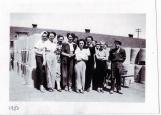 Credits:
Credits:Friends of Medalta Archives
16
His staff, in later years, was comprised wholly of women whose work, in large part, was banding which entailed putting coloured lines on thousands of pieces of hotel ware. Certainly during the '40s and 50s, there was only one exception - Ernie Hehr who came on board when the workload became so heavy that Tom needed a foreman, especially for the glazing area. In the next room, the finished goods were packed and some of that work was done by prisoners of war. Sometimes, Tom would give them clay to model things for themselves. He would then glaze and fire them. There are insufficient records to ascertain the who, what and how of the early days in the art department.Tom had input on all proposed product designs, mould making, decoration, and glazes. He was often experimenting with new colours, testing them on samples and firing them. From time to time, there would be a special order to work on, such as the Malibu Club, the Palomino Restaurant and the Banff School of Fine Art.
17
Pitcher20th Century, Circa late 1940's
Medalta Potteries Limited, Medicine Hat, Alberta, Canada
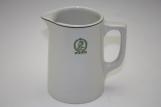 Credits:
Credits:Medalta Potteries Limited
18
One of the more unusual assignments he had was to design and execute a complete dinner ware set for the royal household kitchen staff of Hailie Selassie, Emperor of Ethiopia. Selassie was considered by Rastafarians to be the messiah predicted in the teachings of Jamaican "Back to Africa" movement leader Marcus Garvey. Medalta had to ensure that any defective dishes in the set were destroyed on the premises. Those who worked on the Selassie ware were carefully checked when they left the plant at the end of the day. Pockets, lunch pails and purses were searched to ensure that none of the pieces went out of the factory.19
Medalta catalogue20th Century, Circa 1947
Medicine Hat, Alberta, Canada
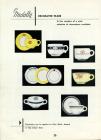 Credits:
Credits:Friends of Medalta Society Archives
